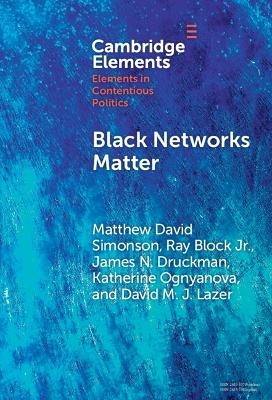
Black Networks Matter
The Role of Interracial Contact and Social Media in the 2020 Black Lives Matter Protests
Seiten
2024
Cambridge University Press (Verlag)
978-1-009-47570-9 (ISBN)
Cambridge University Press (Verlag)
978-1-009-47570-9 (ISBN)
This Element addresses questions about the role played by interpersonal networks play in mobilizing social movements by theorizing about three dimensions of ties: emotionally strong or weak, movement insider or outsider, and ingroup or cross-cleavage. This title is also available as Open Access on Cambridge Core.
Scholars have long recognized that interpersonal networks play a role in mobilizing social movements. Yet, many questions remain. This Element addresses these questions by theorizing about three dimensions of ties: emotionally strong or weak, movement insider or outsider, and ingroup or cross-cleavage. The survey data on the 2020 Black Lives Matter protests show that weak and cross-cleavage ties among outsiders enabled the movement to evolve from a small provocation into a massive national mobilization. In particular, the authors find that Black people mobilized one another through social media and spurred their non-Black friends to protest by sharing their personal encounters with racism. These results depart from the established literature regarding the civil rights movement that emphasizes strong, movement-internal, and racially homogenous ties. The networks that mobilize appear to have changed in the social media era. This title is also available as Open Access on Cambridge Core.
Scholars have long recognized that interpersonal networks play a role in mobilizing social movements. Yet, many questions remain. This Element addresses these questions by theorizing about three dimensions of ties: emotionally strong or weak, movement insider or outsider, and ingroup or cross-cleavage. The survey data on the 2020 Black Lives Matter protests show that weak and cross-cleavage ties among outsiders enabled the movement to evolve from a small provocation into a massive national mobilization. In particular, the authors find that Black people mobilized one another through social media and spurred their non-Black friends to protest by sharing their personal encounters with racism. These results depart from the established literature regarding the civil rights movement that emphasizes strong, movement-internal, and racially homogenous ties. The networks that mobilize appear to have changed in the social media era. This title is also available as Open Access on Cambridge Core.
1. Modern social movements; 2. The ties that mobilize; 3. Measuring mobilization; 4. Tie strength and mobilization mechanisms; 5. Movement insiders and outsiders; 6. Beyond the contact hypothesis: mobilizing allies; 7. Conclusion: where do we go from here?; References.
| Erscheinungsdatum | 06.02.2024 |
|---|---|
| Reihe/Serie | Elements in Contentious Politics |
| Zusatzinfo | Worked examples or Exercises |
| Verlagsort | Cambridge |
| Sprache | englisch |
| Maße | 152 x 229 mm |
| Gewicht | 274 g |
| Themenwelt | Sozialwissenschaften ► Politik / Verwaltung |
| Sozialwissenschaften ► Soziologie ► Makrosoziologie | |
| ISBN-10 | 1-009-47570-3 / 1009475703 |
| ISBN-13 | 978-1-009-47570-9 / 9781009475709 |
| Zustand | Neuware |
| Haben Sie eine Frage zum Produkt? |
Mehr entdecken
aus dem Bereich
aus dem Bereich
deutsch-jüdische Lebensgeschichten
Buch | Hardcover (2024)
Wallstein Erfolgstitel - Belletristik und Sachbuch (Verlag)
48,00 €
Leben und Zeit von Lucy Parsons
Buch | Softcover (2023)
Edition Nautilus GmbH (Verlag)
34,00 €


